Su
5145 Wellington Street (between 6ième Avenue and Descharmais Boulevard)
Verdun, Quebec H4G 1Y2
(514) 362-1818
www.restaurantsu.com
Hours: Tues-Fri: 11 a.m. – 10 p.m.; Sat-Sun: 4-10 p.m.; Closed Mon.
Vegetarian-friendly
Average for meal/person, excluding wine, taxes, and tip: $20-$40
Major cards and Interac
Rating: ◊◊◊½ (very good)

Turkish coffee and lokum
For many people from the Western World, Turkish cuisine evokes an enticing, exotic culinary culture of intrigue, fascination, and splendour. Grilled kebabs threaded onto skewers, soft squares of rose-scented lokum confection, and overturned Turkish coffee cups for mystical coffee ground readings are a few images that come to mind when we think about the culinary arts and traditions of Turkey, the picturesque land situated at the crossroads of the Far East and the Mediterranean, and a welcoming ground for a panoply of cultures to intermingle. Considered as one of the three grand cuisines in the world, Turkish cuisine owes its present richness and diversity to the landscape’s distinctive regional styles of cooking and to the assimilation, fusion, and refinement of Central Asian, Middle Eastern, and Balkan culinary legacies.
There are, surprisingly, very few restaurants that offer authentic Turkish dishes, particularly when we compare with the popularity of the other two great cuisines of the world, those of French and Chinese, in the city of Montreal. When I had heard about the restaurant Su and eventually the rave reviews that it has been receiving since it opened in early November 2006, I had to visit the place. So recently, on a Saturday evening in early spring, I, along with my dining companion, finally headed out to the borough of Verdun to see what was the foodie commotion all about.

Nazar boncuk—Turkish talisman of the evil eye
The name of the restaurant, “Su,” means “water” in Turkish, and we discovered an oasis of joie de vivre nestled along the principal restaurant street of Verdun. Inside, my dining companion and I sensed immediately a welcoming conviviality and warm ambiance radiating from the elegant dining space of candlelit tables. Rich, dark colors of autumn red, chocolate brown, and mustard yellow, with frequent punctuations of neutral white, blended harmoniously in the room. Turkish ceramic plates, historic prints, and artwork bearing the nazar boncuk, the Eastern Mediterranean and Middle Eastern evil-eye talisman, decorated gracefully the various walls of the dining space.
The restaurant was packed upon our arrival. “Always a good sign,” remarked my dining companion. And the owners of the restaurant, a husband-and-wife duo, who also run the place, were busy as bees that night. With the help of the wait staff, the husband, Tulga Kalayci, was taking care of the numerous diners in the room, while his chef-wife Fisun Ercan was working her culinary magic in the kitchen, creating gourmet dishes, all prepared with fresh ingredients, a hallmark of Turkish cooking, with the assistance of her kitchen helpers.
The menu displayed a large, selective variety of Turkish dishes, principally Ottoman delicacies, and there was something in the menu that would please every palate, whether you fancied a vegetarian, cheese, meat, or seafood dish. It is always a challenge to decide what to order, especially when everything listed on the menu looked delicious! But after delving deep into the menu, we decided to share two mezes and two principal dishes.
We were keen on trying the yaprak sarmasi, an appetizer of stuffed vine leaves, but our courteous waitress informed us regrettably that the kitchen happened to have run out of the yaprak during that evening and, therefore, was no longer available. After consulting with our waitress, we settled on her recommendation of the garnished artichoke dish and opted for a mélange of eggplant and green pepper as our second meze.
As we waited for our meal, we nibbled on the restaurant’s complimentary homemade bread, napkin-wrapped in a basket. Service was slow that night since the restaurant was at full capacity, and the kitchen staff was doing its best to prepare the numerous dish orders as promptly as it could. When the mezes arrived at our table, we were handsomely rewarded for our patience.
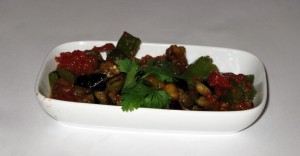
Shakshuka—fried slices of eggplant and green peppers
Served cold, the mezes were presented with simplicity and elegance. The shakshuka, similar to ratatouille, was a delectable blend of fried slices of eggplant and green peppers bathed in a Turkish tomato sauce and embellished with a sprig of coriander. Here, the layered flavours were beautifully nuanced and well-balanced. Even more spectacular was the zeytinyagli enginar, which was a delight for the eye and palate. Braised in olive oil, the two artichoke bottoms were garnished lavishly with a colourful mixture of diced potatoes, carrots, green peas, and chopped dill; to complete the presentation, the assembled vegetable creations were crowned with sprigs of dill. Light and refreshing, the dish revealed an unpretentious interplay of subtle flavours and textures. Both mezes, which proved to be very fitting for a spring meal, showcased chef Ercan’s culinary ability to transform such humble vegetables into two sophisticated dishes. And thus, the meal began on an exquisite note.
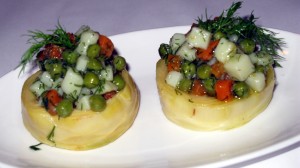
Zeytinyagli enginar—garnished artichokes braised in olive oil
Contrasting in composition, the selected pièces de résistance also scored high marks. The manti, Turkish ravioli, was one of the specialty dishes of the Ottoman Empire. Boiled and then drained, the small pinched dough dumplings were filled with minced beef and herbs and accompanied with a liberal serving of garlic yogurt sauce that was enhanced with splashes of peppered tomato and oil tinged with spices. Delicate and delicious, the Turkish pasta dish was light due to the use of yogurt in the sauce. Another authentic Ottoman treat, the karisik izgara, inspired by the cooking style of the ancient nomadic Turks in Central Asia, was a dish of assorted grilled meats that was served with a generous pile of rice decorated with a mixed variety of vegetables— chopped red peppers, thinly julienned carrots and cucumbers, a green haricot, and a slice of grilled green pepper. (Many of the meat and seafood dishes, including the karisik izgara, come with a choice of rice or bulgur which our waitress had forgotten to ask during our order.) Among the grilled meats, we tasted a sampling of köfte, a ground beef patty, and a round of sucuk, a Turkish beef sausage, both flavourfully seasoned with spices. We also enjoyed the escalope of chicken breast which was accented with an elegant touch of mint. But it was the lamb chop that was the standout of the dish. Succulent and extremely tender, the meat just melted in our mouths. It was so scrumptious that my dining companion was already planning another visit to the restaurant so that he could order a whole plate of lamb chops for himself.
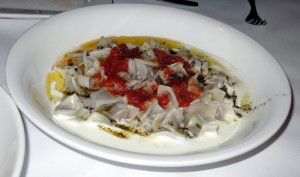
Manti—Turkish ravioli
We still had room for a dessert course, so we decided to round off our meal with two sweets. The dessert du jour that night was a set of three kemal pasha mignardises, a well-known specialty of the Aegean and Marmara regions. (Incidentally, the dessert was named after the founder of the republic of Turkey and eventually its first president.) Soaked in rose-water syrup, each of the three miniature round pastries was embellished with an edible rose petal atop piped fresh cream and spiced sparingly with a speck of clove. Similar to the Greek Christmas honey cookie melomakarona, the eponymous delicacy was pleasurably sweet and very moist yet firm in texture due to the dough base which was prepared with fresh white cheese. We also savoured a coffee mousse which was originally designated mistakenly by our soft-spoken waitress as the dessert du jour; coffee lovers would find the dessert very gratifying as the mousse was very smooth and intense in coffee flavour. My dining companion enjoyed the mousse more than his accompanying Turkish coffee, which was paired with a small cube of (pistachio) Turkish delight, customarily served as a sweet foil to the dark, bitter coffee. While his coffee was presented in a typical porcelain fincan, my çay, a strong, full-flavoured Turkish black tea, was poured in a customary small tulip-shaped glass.
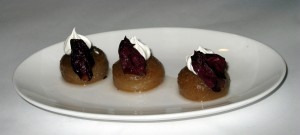
Kemal pasha mignardises
The modest chef Ercan did make an appearance outside the kitchen late that night and, as an appreciative gesture, greeted some of the remaining diners in the dining room. We were delighted to meet, and to exchange a few words with, her. Soft-spoken, Ercan, who is originally from Turkey, followed her heart and has now become an artisan chef who cooks and creates from the heart. The dishes relished that evening exuded her passion for cooking, all prepared and presented with love, care, and simplicity. I, too, was already thinking of returning to the restaurant to savour other royal culinary treats from the Su kitchen.
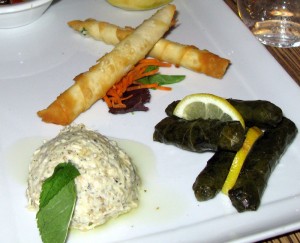
Assorted mezes, clockwise from top: sigara boregi—deep-fried cheese-filled rolls, yaprak sarmasi—stuffed vine leaves, and yogurtlu patlican ezme—garlic yogurt eggplant caviar
I revisited Su another evening, this time with a different dining companion. During this visit, we decided to take advantage of a selective assortment of five vegetarian mezes, namely, deep-fried cheese-filled rolls, eggplant caviar, stuffed vine leaves (which were available this time), shakshuka again, and yet again, the divine garnished artichokes braised in olive oil, all of which were assembled elegantly on a large oblong-shaped plate. The two sigara boregi, placed at the center of the serving plate and set on top of a tiny pile of baby leaf vegetables and thin carrot strips, was the only appetizer that was served hot. Made with feta cheese and phyllo dough, these wonderfully toothsome Turkish cigar-shaped pastries were crisp and grease-free on the outer casing and velvety in the interior. The yogurtlu patlican ezme, a chilled meze made from a blend of eggplant purée, yogurt, garlic, and olive oil, was molded into a round mound and decorated with mint leaves. Mildly flavoured, the creamy dip-spread was pleasing even on its own. Even more delectable were the four yaprak sarmasi, dolmas made with vine leaves filled with rice, pine nuts, Corinthian raisins, and mint. Squirts of lemon juice from the accompanying slices of lemon added a refreshing touch to the subtle flavours of the slender steamed rolls. And the zeytinyagli enginar proved to be again an unbeatable favourite. My dining companion enjoyed the artichoke appetizer so immensely that he finished every last morsel that he could find remaining on the serving plate.
During the course of the meal, we sipped pleasurably an apéritif of raki, a traditional strong Turkish spirit, which we diluted with water and ice. (When mixed with water, the clear, colorless distilled drink turns milky white, and hence, the origin of its nickname arslan sütü or “lion’s milk.”) Very similar to Greek ouzo and Eastern Mediterranean arak, the apéritif had a very pronounced anise flavour, but to our pleasant surprise, it was impressively smooth. Wow.
Service was well-paced during this evening as the restaurant was not completely at full capacity. We didn’t have to wait too long for the main course to arrive at our table.

Tavsan yahnisi—braised rabbit with black grape sauce
Our selection of principal dishes, par hasard, incorporated an element of fruit in the preparation of the meats. In the dish intriguingly called afrodiziak tavuk, the grilled grain-fed chicken filet was served in an “aphrodisiac” sauce and covered lavishly with luscious cooked dried apricots, prunes, and slivered grilled almonds. My dining companion, who has a strong liking towards Greek-style grilled chicken, found the meat a tad dry for his taste. More delightful was the tavsan yahnisi. Braised in a black grape sauce, the savoury and tender leg of rabbit was garnished liberally with cooked large black grapes and a sprig of coriander. In both dishes, the meat was accompanied with a plentiful heaping of cooked bulgur—fluffy but just slightly on the dry side—that was jazzed up with playful strands of haricots and julienned red peppers, carrots, and green onion.

Kalburabasti—walnut-filled cookie
For dessert, we shared a plate of kalburabasti, which was paired with a tart gooseberry. Sprinkled with finely chopped green pistachio nuts, the oval, cocoon-shaped cookie was saturated with honey syrup and stuffed with chopped walnuts.
Su offered other teas besides çay, including tisane teas of ihlamur (linden-flower tea) and ada çayi or “island tea” (sage tea) which were served in cups. As we sipped our tea, we rediscovered simplicity at Su and realized that sometimes the most pleasurable things in life are the simple things.
Elinize Saglik!
Tags: afrodiziak tavuk, çay, chef, fine cuisine, fine dining, Fisun Ercan, kalburabasti, karisik izgara, kemal pasha, köfte, manti, mezes, Montreal, Restaurant, shakshuka, sigara boregi, Su, sucuk, tavsan yahnisi, Turkish food, yaprak sarmasi, yogurtlu patlican ezme, zeytinyagli enginar
